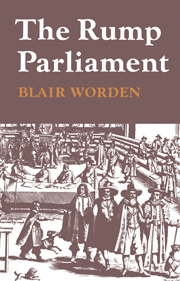Book contents
- Frontmatter
- Contents
- Dedication
- Acknowledgements
- Author's Note
- List of abbreviations
- Introduction
- PART ONE THE RUMP AND THE RUMPERS
- PART TWO THE RUMP AND REFORM
- PART THREE THE STRUGGLE FOR SURVIVAL, FEBRUARY 1649–SEPTEMBER 1651
- 9 Problems and policies, February 1649
- 10 The pursuit of respectability, February–August 1649
- 11 The nadir, September 1649–September 1650
- 12 Dunbar to Worcester: the coalition under strain, September 1650–September 1651
- PART FOUR PARLIAMENT versus THE ARMY, SEPTEMBER 1651–APRIL 1653
- PART FIVE THE DISSOLUTION OF THE RUMP
- APPENDICES
- Bibliographical Guide
- Index
9 - Problems and policies, February 1649
Published online by Cambridge University Press: 29 January 2010
- Frontmatter
- Contents
- Dedication
- Acknowledgements
- Author's Note
- List of abbreviations
- Introduction
- PART ONE THE RUMP AND THE RUMPERS
- PART TWO THE RUMP AND REFORM
- PART THREE THE STRUGGLE FOR SURVIVAL, FEBRUARY 1649–SEPTEMBER 1651
- 9 Problems and policies, February 1649
- 10 The pursuit of respectability, February–August 1649
- 11 The nadir, September 1649–September 1650
- 12 Dunbar to Worcester: the coalition under strain, September 1650–September 1651
- PART FOUR PARLIAMENT versus THE ARMY, SEPTEMBER 1651–APRIL 1653
- PART FIVE THE DISSOLUTION OF THE RUMP
- APPENDICES
- Bibliographical Guide
- Index
Summary
The Rump, surrounded by enemies both at home and abroad, was faced from the start by problems of daunting magnitude. When governments have survived crises, it is sometimes difficult to realise how grave the crises were. The Commonwealth's survival between 1649 and 1651 was a remarkable, and to contemporaries often a surprising, achievement.
The thrill of horror which ran through England at the execution of Charles I spread quickly to the continent, where the previous decade had likewise been one of acute political instability, and where rulers were understandably alarmed by the murder of one of God's anointed kings. Unhappily for Charles II's exiled court, resolved to regain the throne and anxious for continental support for an invasion, the expressions of grief and condolence proffered by European governments were not matched by supplies of arms, money or men, let alone by open declarations of hostility to the new republic. Such parsimony, although politically and financially unavoidable, could hardly be predicted, and could certainly not be taken for granted, by the infant Commonwealth. Indeed, although France and Spain remained at war, and consequently were unable to contemplate open aggression towards England, the conclusion of the Thirty Years War in 1648 left the new government diplomatically isolated, perilously exposed, and struggling for formal recognition by European powers. If the conduct of continental governments towards the Rump was a matter for worried speculation, the behaviour of its enemies in Ireland and Scotland presented a more immediate threat.
- Type
- Chapter
- Information
- The Rump Parliament 1648–53 , pp. 163 - 185Publisher: Cambridge University PressPrint publication year: 1974



